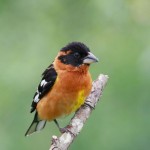
Until recently, some of our most exotic Valley birds could be found only by hard core birders with special knowledge not only of what to look for, but where and when to find it. Thus, those who wished to see the spectacular Blue Grosbeak, our most recently featured, “Target Bird,” were limited to a few locations where the bird might be seen, and most of the locations featured limited public access.
Now, however, the opening of the southern entrance to the San Joaquin River National Wildlife Refuge has changed wildlife viewing opportunities much for the better. Located at the eastern terminus of Dairy Road, just off River Road in western Stanislaus County, the refuge features a convenient parking lot, clean restrooms, and an almost four mile long trail loop (the Pelican Nature Trail) through carefully restored riparian and wetland habitat.
In addition to providing a summer home and breeding locale for the Blue Grosbeak, the riparian habitat along the trail loop also hosts another large-billed exotic, the Black-headed Grosbeak. Both birds winter from Mexico to points south, and because of their bold colors, both suggest the tropics or South American jungles. Nonetheless, these brilliantly plumaged birds are our own summer residents, and should be on everyone’s list of local birds seen in their historic Valley habitat.
To “target” the Black-headed Grosbeak, study the distinctively different male and female plumages in your bird book. Note the bold orange, black, and white pattern of the male, as it is most likely you’ll see the colorful male more easily than the drab female. Then, review the male and female plumages of the Blue Grosbeak. Finally, study another boldly patterned orange, black and white bird, the (Northern) Bullock’s Oriole. These brilliant birds also can be found along the trail loop at the wildlife refuge.
Once you’ve gotten clear images in your mind of what to look for, plan on arriving at the refuge during the early morning hours, when the birds are most vocal and active. By midday the birds quiet down to escape the summer heat. Most people hear Black-headed Grosbeaks before they see them. The song is loud, exuberant, and distinctive. You can review it here.
Once at the refuge, follow the trail loop along Hospital Creek. The cottonwoods and willows in the creek are the most likely places for both Black-headed Grosbeak and Bullock’s Oriole, while the bushes and shrubs on the opposite side of the trail are most likely to harbor a Blue Grosbeak. However, any of these birds might be seen anywhere on the refuge during the summer months, so be alert.
With really good luck, you’ll accomplish one of our specialty trifectas, and see all three species. And even if you miss these spectacular birds, you’re guaranteed a wildlife spectacle, as the refuge is host to avian and animal species too numerous to list. Don’t forget to look overhead: You might see anything from a soaring hawk to a circling kettle of White Pelicans. And good luck with yet another Valley trifecta, this one featuring exotic birds worthy of the tropics.

I live in Modesto. I had one of these fellows in my back yard. Never had seen one before.
Is it normal for these birds to be in Modesto? I’ve also had the female at my bird fountain.
Kim: While Black-headed Grosbeaks are more common in our riparian woodlands, it’s not particularly unusual to see them in Modesto. They especially like bird feeders with seeds.